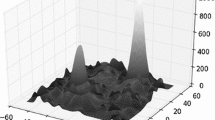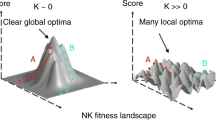Abstract
There is growing interest in understanding and eliciting division of labor within groups of scientists. This paper illustrates the need for this division of labor through a historical example, and a formal model is presented to better analyze situations of this type. Analysis of this model reveals that a division of labor can be maintained in two different ways: by limiting information or by endowing the scientists with extreme beliefs. If both features are present however, cognitive diversity is maintained indefinitely, and as a result agents fail to converge to the truth. Beyond the mechanisms for creating diversity suggested here, this shows that the real epistemic goal is not diversity but transient diversity.







Similar content being viewed by others
Notes
When defending alternatives to the classic interpretation of quantum mechanics, Feyerabend succinctly declares, “It takes time to build a good theory” (1968, p. 150).
Feyerabend is perhaps the most extreme in this regard. He says, “This plurality of theories must not be regarded as a preliminary stage of knowledge that will at some time in the future be replaced by the ‘one true theory.’" (1965, p. 149). But even in papers of this era (1965, 1968), he does not advocate holding onto inferior theories indefinitely.
This result is explicitly impossible in the models considered by Kitcher and Strevens. In their models a theory succeeds or fails and this success or failure is known by all agents.
Although, bismuth (an antimicrobial) had been used to treat ulcers dating as far back as 1868, the first report of an antibiotic occurs in 1951 (Unge 2002).
Marshall speculates that the long delay between the reports of his own discovery and the widespread acceptance of the bacterial hypothesis were (partially) the result of the financial interests of pharmaceutical companies (Marshall 2002). While this may be an example of pathological science, the dismissal of the bacterial hypothesis from 1954 to 1985 probably is not.
For example, a recent study on the effect of circumcision on the transmission of HIV was stopped in order to offer circumcision to the control group because the effect was found to be very significant in the early stages of research.
Nothing requires that we limit ourselves in this way. The models described later in this paper have a larger set of possible outcomes.
This point is due to a conversation with Michael Weisberg and Ryan Muldoon. They present a rather different model of scientific practice which centrally models science in this way (Weisberg and Muldoon 2008).
Although evidence is always arriving, what evidence arrives depends on the actions taken by individual scientist. Their actions, depend, in turn, on what their beliefs are about the efficacy of different methodologies. This represents a violation of the “relative autonomy of facts” which is criticized by Feyerabend (1965, 1968).
The chose of [0, 4] was chosen so that the initial beliefs do not swamp even a single experimental result.
Each trial represents 1,000 “pulls”, which have a 0.5 and 0.499 probability of “winning” respectively.
These results are qualitatively similar to the results obtained by Zollman (2007) in studying a more limited model. This lends additional support to the conclusion that bandit problem-like situations information is not uniformly helpful.
In this case α and β are drawn from a uniform distribution on [0,7000].
For a rather different discussion of the two sides of this debate see (Laudan 1984).
References
Alexander, J. M. (2007). The structural evolution of morality. Cambridge: Cambridge University Press.
Bala, V., & Goyal, S. (1998). Learning from neighbours. Review of Economic Studies, 65, 565–621.
Berry, D. A., & Fristedt, B. (1985). Bandit problems: Sequential allocation of experiments. London: Chapman and Hall.
Buckley, M. J., & O’Morain, C. A. (1998). Helicobacter biology—discovery. British Medical Bulletin, 54(1), 7–16.
DeGroot, M. H. (1970). Optimal statistical decisions. NY: McGraw-Hill.
Feyerabend, P. (1965). Problems of empiricism. In R. G. Colodny (Ed.), Beyond the edge of certainty. Essays in contemporary science and philosophy (pp. 145–260). Englewood Cliffs NJ: Prentice-Hall.
Feyerabend, P. (1968). How to be a good empiricist: A plea for tolerance in matters epistemological. In P. Nidditch (Ed.), The philosophy of science. Oxford readings in philosophy (pp. 12–39). Oxford: Oxford University Press.
Figura, N., & Bianciardi, L. (2002). Helicobacters were discovered in Italy in 1892: An episode in the scientific life of an eclectic pathologist, Giulio Bizzozero. In B. Marshall (Ed.), Helicobacter pioneers: Firsthand accounts from the scientists who discovered Helicobacters, (pp. 1–13). Victoria, Australia: Blackwell Science Asia.
Fukuda, Y., Shimoyama, T., Shimoyama, T., & Marshall, B. J. (2002). Kasai, Kobayashi and Koch’s postulates in the history of Helicobacter pylori. In B. Marshall (Ed.), Helicobacter pioneers, (pp. 15–24). Oxford: Blackwell publishers.
Goyal, S. (2005). Learning in networks: A survey. In G. Demange & M. Wooders (Eds.), Group formation in economics: networks, clubs, and coalitions. Cambridge: Cambridge University Press.
Howson, C., & Urbach, P. (1996). Scientific reasoning: The Bayesian approach (2nd ed). Chicago: Open Court.
Hull, D. (1988). Science as a process. Chicago: University of Chicago Press.
Kidd, M., & Modlin, I. M. (1998). A century of Helicobacter pylori. Digestion, 59, 1–15.
Kitcher, P. (1990). The division of cognitive labor. The Journal of Philosophy, 87(1), 5–22.
Kitcher, P. (1993). The advancement of science. New York: Oxford University Press.
Kitcher, P. (2002). Social psychology and the theory of science. In S. Stich & M. Siegal (Eds.), The cognitive basis of science. Cambridge: Cambridge University Press.
Kuhn, T. S. (1977). Collective belief and scientific change. In The essential tension (pp. 320–339). University of Chicago Press.
Laudan, L. (1984). Science and values. Berkeley: University of California Press.
Laudan, L. (1996). Beyond positivism and relativism: Theory, method, and evidence. Boulder: Westview Press.
Marshall, B. (2002). The discovery that Helicobacter pylori, a spiral bacterium, caused peptic ulcer disease. In B. Marshall (Ed.), Helicobacter pioneers: First hand accounts from the scientists who discovered Helicobacters (pp. 165–202). Victoria, Australia: Blackwell Science Asia.
Palmer, E. (1954). Investigations of the gastric mucosa spirochetes of the human. Gastroenterology, 27, 218–220.
Peterson, W. L., Harford, W., & Marshall, B. J. (2002). The Dallas experience with acute Helicobacter pylori infection. In B. Marshall (Ed.), Helicobacter pioneers: Firsthand accounts from the scientists who discovered Helicobacters (pp. 143–150). Victoria, Australia: Blackwell Science Asia.
Popper, K. (1975). The rationality of scientific revolutions. In R. Harre (Ed.), Problems of scientific revolution: Progress and obstacles to progress. Oxford: Clarendon Press.
Rigas, B., & Papavassiliou, E. D. (2002). John Lykoudis: The general practitioner in Greece who in 1958 discovered the etiology of, and a treatment for, peptic ulcer disease. In B. Marshall (Ed.), Helicobacter pioneers (pp. 75–87). Oxford: Blackwell publishers.
Robbins, H. (1952). Some aspects of the sequential design of experiments. Bulletin of the American Mathematical Society, 58, 527–535.
Sarkar, H. (1983). A theory of method. Berkeley: University of California Press.
Solomon, M. (1992). Scientific rationality and human reasoning. Philosophy of Science, 59(3), 439–455.
Solomon, M. (2001). Social empiricism. Cambridge, MA: MIT Press.
Strevens, M. (2003a). Further properties of the priority rule. Manuscript.
Strevens, M. (2003b). The role of the priority rule in science. Journal of Philosophy, 100(2), 55–79.
Thagard, P. (1993). Societies of minds: Science as distributed computing. Studies in History and Philosophy of Science, 24, 49–67.
Thagard, P. (1998a). Ulcers and bacteria I: Discovery and acceptance. Studies in History and Philosophy of Science. Part C: Studies in the History and Philosophy of Biology and Biomedical Sciences, 29(1), 107–136.
Thagard, P. (1998b). Ulcers and bacteria II: Instruments, experiments and social interactions. Studies in History and Philosophy of Science. Part C: Studies in History and Philosophy of Biological and Biomedical Sciences, 29, 317–342.
Unge, P. (2002). Helicobacter pylori treatment in the past and in the 21st century. In B. Marshall (Ed.), Helicobacter pioneers: Firsthand accounts from the scientists who discovered Helicobacters (pp. 203–213). Victoria, Australia: Blackwell Science Asia.
Warren, J. R., & Marshall B. J. (1984). Unidentified curved bacilli on gastric epithelium in active chronic gastritis. Lancet, 1(8390), 1311–1315.
Weisberg, M., & Muldoon R. (2008). Epistemic landscapes and the division of cognitive labor. Philosophy of Science, forthcoming.
Zollman, K. J. (2007). The communication structure of epistemic communities. Philosophy of Science, 74(5), 574–587.
Acknowledgments
The author would like to thank Brian Skyrms, Kyle Stanford, Jeffrey Barrett, Bruce Glymour, Sam Hillier, Samir Grover, Kevin Kelly, Teddy Seidenfeld, Michael Strevens, Michael Weisberg, Ryan Muldoon, several contributors at the Wikipedia reference desk, and the anonymous referees for their assistance. Code for the simulations can be obtained from the author’s website: http://www.andrew.cmu.edu/users/kzollman/.
Author information
Authors and Affiliations
Corresponding author
Rights and permissions
About this article
Cite this article
Zollman, K.J.S. The Epistemic Benefit of Transient Diversity. Erkenn 72, 17–35 (2010). https://doi.org/10.1007/s10670-009-9194-6
Received:
Accepted:
Published:
Issue Date:
DOI: https://doi.org/10.1007/s10670-009-9194-6




